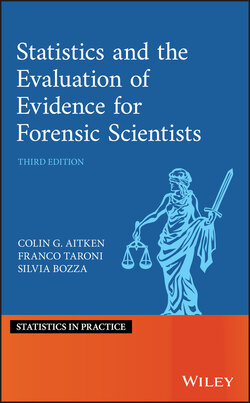Читать книгу Statistics and the Evaluation of Evidence for Forensic Scientists - Franco Taroni - Страница 23
1.5 Types of Data
ОглавлениеA generic name for observations that are made on items of interest, such as bloodstains, refractive indices of glass, etc. is data. There are different types of data and some terminology is required to differentiate amongst them. For example, consider shoe types. The observations of interest are the shoe types as observable on surveillance camera recordings and those observable in possession of a PoI. These shoe types are not quantifiable. There is no numerical significance that may be attached to these. The shoe type is a qualitative characteristic. As such, it is an example of so‐called qualitative data, sometimes known as categorical data. The observation of interest is a quality, the shoe type, which has no numerical significance. The different shoe types are sometime known as categories. The assignation of a shoe to a particular category is called a classification. A shoe may be said to be assigned to one of several categories (see the discussion on the definition of identification in Section 2.5.9). Other examples of categorical data include types of firearms and makes of cars.
It is not possible to order shoe types and say that one type is larger or smaller than another. However, there are other qualitative data that do have a natural ordering, such as the level of burns on a body. There is not a numerical measure of this but the level of burns may be classified as first, second, third degree, for example. Qualitative data that have no natural ordering are known as nominal data. Qualitative data to which a natural ordering may be attached are known as ordinal data. An ordinal characteristic is one in which there is an underlying order even though it is not quantifiable. Pain is another such characteristic; level of trauma may be ordered as none, slight, mild, severe, or very severe. The simplest case of nominal data arises when an observation may be classified into one of only two possible categories. For example, consider the magnetism of toner present on printed documents. Some toners are magnetic, whereas others are not. Such data are known as binary. Alternatively, the variable of interest, here magnetism, is known as dichotomous; it is either present or absent (Biedermann et al. 2016c).
Other types of data are known as quantitative data. These may be either counts (known as discrete data, since the counts take discrete, integer, values) or measurements (known as continuous data, since the measurements may take any value on a continuous interval).
A violent crime involving several people, victims and offenders, may result in much blood being spilt and many stains from each of several DNA profiles being identified. Then the numbers of stains for each of the different profiles are examples of discrete, quantitative data. Other examples of discrete quantitative data are the number of glass fragments found on a PoI, or the number of gunshot residue particles on hands.
The refractive indices and elemental concentrations of glass fragments are examples of continuous measurements. In practice, variables are rarely truly continuous because of the limits imposed by the sensitivity of the measuring instruments. For example, refractive indices may be measured only to a certain number of decimal places.
Observations, or data, may thus be classified as qualitative or quantitative. Qualitative data may be classified further as nominal or ordinal, and quantitative data may be classified further as discrete or continuous.
